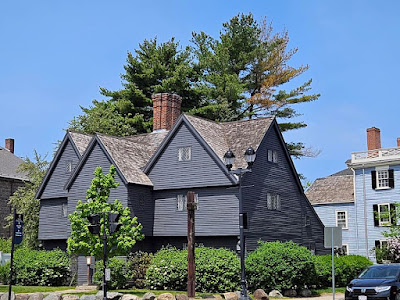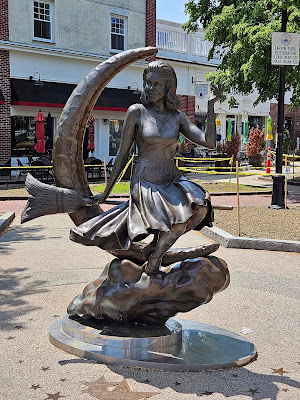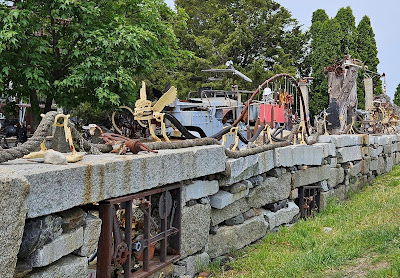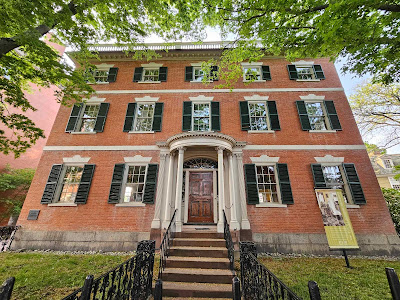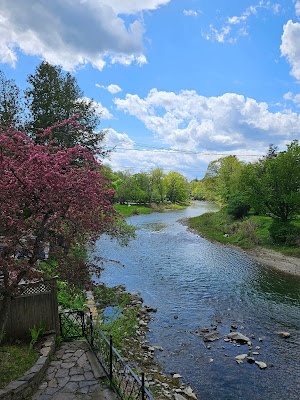On May 28, I ran the Coeur d’Alene Marathon in northern Idaho. When I ran this race in 2017, I started to have unusual pains on the left side of my chest. It turned out to be a nerve impingement from a herniated disk. That injury required surgery. It took a long time to heal, but I eventually made a full recovery. I didn’t have any problems this year.
Most of my recent trips
have been longer trips that included sightseeing. This was a quick trip. I was just there to run the marathon.
The closest major airport
to Coeur d’Alene is in Spokane, WA. I
was able to get a direct flight to Spokane.
From there, it’s a 40-mile drive to Coeur d’Alene. I flew to Spokane on Saturday and arrived at
my hotel in Coeur d’Alene in the early afternoon.
Packet pickup was at McEuen
Park, which is on the shore of Lake Coeur d’Alene. This park is also where the race starts and
finishes. They had a small expo set up
in the park.

The race T-shirt had a design
in the shape of Idaho. I was surprised
that it said, “Finisher,” because we got the shirt at packet pickup.
I wanted to get to bed early,
so I had an early dinner. I found a
brick oven pizza place that I could walk to from my hotel. They opened at 4:00, and I was there when
they opened. After dinner, I walked to a
brewery that was about a mile from the pizza place.
I always pay close attention to
weather forecasts for race day, but I often forget to check the forecast for
the day before or the day after. The
last time I looked, there wasn’t any rain in the forecast for Saturday evening. Apparently, that forecast was out of date.
As I was walking from the
pizzeria to the brewery, I felt a little bit of light drizzle. It was more like a mist. I wasn’t wearing a jacket, so I quickened my
pace. I assumed, naively, that it would
be done before I walked back to the hotel.
I had a beer flight and started
talking to the bartender and two other guys at the bar. When I left, it was sprinkling.
I ducked back inside to check my
weather app. I wondered if the rain
would stop soon if I waited a little longer.
My app said a thunderstorm was going to start in 16 minutes. I looked at radar, and it was obvious that it
was only going to get worse if I waited.
I started walking to the hotel,
but at a brisk pace. Then the sky opened
up. It rained so hard that there were
rivers of rainwater flowing through the streets. It was still more than a mile to my hotel, so
I started running. There’s a limit to
how fast you can run when you’re wearing wet street clothes, and you have a
phone in your pocket. By the time I got
back to the hotel, my clothes and shoes were soaked. Fortunately, they weren’t the same shoes I
was planning to wear for the race.
I still managed to get to bed
early, but I only slept for half the night.
Then I was awake for three or four hours before finally falling asleep
again.
I needed to leave the hotel
before they started their breakfast. I
don’t usually eat much before a race, but I wanted to eat something. I bought a small package of cookies from the
hotel pantry and made a cup of hot cocoa.
The race started at 6:30. There’s a large parking lot at McEuen Park,
but I didn’t know how easy it would be to find a parking spot that was close to
the race. When I was there for the expo,
the parking lot was full.
To make sure I could get a
close parking spot, I arrived more than an hour early. That was excessive. When the race started, there were still
plenty of close parking spaces available.
I could’ve arrived at the last minute.
The temperature at the start
was in the mid-50s. I find that to be
ideal for running a marathon. It was
warm enough that I could wear shorts without worrying about my legs getting
cold. I expected it to warm up about 10
degrees by the time I finished. Some
people might find that to be too hot, but I’m not bothered by temperatures in
the low 60s.
While I was driving to the
race, it was raining lightly. When I got
to McEuen Park, the rain had stopped, but I still felt a fine mist in the
air. That ended before the race started.
The grass was wet, so it was
impossible to walk to one of the port-o-potties without getting your shoes
wet. Then I discovered that the building
where they held packet pickup had bathrooms, and they were open. Hardly anyone seemed to know about these
bathrooms. There wasn’t any line to use
them.
When I ran this race before,
the course was a double loop. Each loop
included a long out-and-back section. The
course only had one big hill, but it was on this out-and-back section, so I had
to run it four times (twice in each direction).
The course has been changed
since then. The new course has two different
out-and-back sections, each starting and finishing at McEuen Park. The first out-and-back includes the same big
hill I remembered. I had to run it twice
(once from each side). The second out-and-back
just has one big hill. It’s uphill as
you climb out of a river valley. The top
of the hill is at the turnaround point.
Then it’s downhill coming back. The
rest of the course isn’t flat, but there aren’t any other hills big enough for
me to worry about them.
Four weeks ago, I broke four
hours on a course that was mostly flat, except for a bridge that we crossed
twice. I wanted to see if I could break
four hours on this course, which is more challenging.
Two weeks ago, I ran a course
with gentle rolling hills, and I found it to be tiring. Since then, I’ve worked larger hills into my
training whenever I could. I’ve worked
hard to be able to take steep hills without slowing down, often pushing myself
into oxygen debt. I came into this race
confident that I would be prepared for the hills.
I had two goals for this
race. The first was to beat 3:59:21. That was my previous best time this
year. My second goal was to run negative
splits.
They had pace groups, but I didn’t
see anyone holding a 4:00 sign. I asked
the 4:15 pacer if there was a 4:00 group.
He said there was supposed to be one, but the 4:00 pacer didn’t show
up. Then I saw he was carrying both the
4:00 and 4:15 signs. He was originally going
to pace the 4:15 group, but he made a last-minute decision to lead the 4:00
group instead. That meant there wasn’t a
4:15 group. He was assuming there would
be more people interested in running a 4:00 pace.
When I found out he was going
to be pacing for 4:00, I asked him how he was planning to handle pacing over
the big hills. He said he was planning
to start at a 9:00 per mile pace. That’s
a little bit faster than the 9:09 pace you need to finish in four hours, but it
would allow us to give back about a minute on each of the three big hills. That’s exactly how I would’ve paced it if I
had to set my own pace, so I started with him and just followed him until we
reached the first big hill.
As we started running, the pace
felt a little tiring, but I stuck with it.
The first block or two may have been slightly uphill. Soon, we reached a downhill stretch, and the
pace suddenly felt much easier.
We started a little faster than
a 9:00 pace. For the first five miles,
every mile was 8:55 or faster. Our pacer
wasn’t too worried about that, as he planned to give back the time on the
hills.
As we got out of town, we were running
on the Northern Idaho Centennial Trail.
This was a paved trail that followed the shore of Coeur d’Alene
Lake. We usually had a nice cool breeze
off the lake.
Although there are only three
big hills, the rest of the course isn’t completely flat. There are lots of smaller undulations. Most of the time, I found our pace to be
comfortable, but occasionally it felt slightly tiring on an uphill section.
In the sixth mile, we reached
the first big hill. We didn’t worry
about staying on pace. We just took it
at a pace that felt manageable. I found
this hill to be tiring, but I ran a pace that wouldn’t break me. We could be as slow as 10 minutes in this
mile and still be on pace. We ended up
running it in 9:11.
The next mile was
downhill. Without trying at all to speed
up, I ran it in 8:36. So far, we were averaging
better than nine minutes, even including the first big hill.
The aid stations usually had
bottles of water and cups filled with Gatorade.
I always drank the Gatorade. At
seven miles, we reached an aid station that only had bottles of water. I decided to skip that aid station and wait
for the next one. As it turned out, the
next aid station was this same one on the way back.
The turnaround for the first
out-and-back was at about eight miles.
Just before the turnaround, we had to go up a hill. It was steep enough that it forced me to slow
down. Fortunately, it wasn’t very
long. After turning around, we went back
down the hill. To run comfortably down
that hill, I had to shorten my stride.
When we got back to the aid
station that just had water, I decided I couldn’t afford to skip it again. I took a bottle of water and slowed to a walk
while drinking as much as I could. I
didn’t want to carry it with me, so I discarded the rest of the bottle. I hate to waste water, but this was the only
aid station where I had to do that. The
rest all had Gatorade in cups.
This aid station had a
port-o-potty that wasn’t occupied, so our pace leader handed his sign to one of
the other runners and told us he would catch up to us as soon as he could. We were about to start up the second big
hill, so he had to work hard to catch up.
Approaching the hill from this
direction, it was longer, but more gradual.
Before the hill, our average pace was under nine minutes per mile. The hill started in mile nine and continued
into mile ten. We ran those miles in
9:13 and 9:15, respectively. By then,
our pace leader had rejoined the group.
Without trying, I picked up my
pace on the downhill side, but I didn’t run excessively fast. I simply ran a little bit fast while feeling
like I was getting a rest break.
After about 11 miles, I was
talking to another runner, and the two of us were getting out in front of the
group. At times, the pace felt tiring. I wanted to slow down, but I was enjoying our
conversation. More than once, I told him
I would have to slow down. Then he
slowed down too. It was never long,
though, before we were going too fast again.
We were running a pace in the low 8:50s.
At halfway, I was on pace to
finish in about 3:55. At this point, I
was pretty confident about beating 3:59:21, but I thought I had sabotaged my
chances of running negative splits by running the first half too fast.
As we got back into town, we
were on city streets for a couple miles.
We knew we were way ahead of the 4:00 group, so we took a short walking
break on a small hill. In the next mile,
there was a steeper hill. I walked most
of the hill, and then noticed the guy I was talking to earlier had fallen
behind and never caught up, even though I was walking.
When I reached the top of that
hill, I was running by myself, so I decided to see if I could get back to my
previous pace. Now that I was well into
the second half of the race, I was more willing to put some effort into my
pace. I had not yet given up on running
negative splits, although it seemed optimistic.
Coming back through McEuen
Park, I picked up my pace. Miles 15 and
16 had taken 9:23 and 9:08 respectively.
Now I wanted to see if I could gradually make up the lost time and get
my average pace back into the 8:50s.
I ran mile 17 in 8:44. If I could keep up that pace, I would run
negative splits, but I still had nine miles to go. I took it one mile at a time and kept
pushing.
I was now on the second
out-and-back, which was on the west side of town. I was back on the Northern Idaho Centennial
Trail, but now the trail was following the Spokane River.
A few miles earlier, the sun
was peeking through the clouds. I
wondered if the second half of the race would get hot if the sun came out
completely. That never happened. There was a nice cool breeze blowing through
the river valley, and it gradually got cloudy again. I didn’t feel any warmer in the second half than
I did in the first half. I always felt
comfortable.
I kept up my effort in mile 18,
but slowed slightly. I ran that mile in
8:46. That was still fast enough. That gave me enough confidence, that I sped
up to 8:34 in the next mile. That was my
fastest mile so far. It was faster than
I had run earlier in a downhill mile.
After that, it got
tougher. In mile 20, I slowed to 8:44
again. I felt like I was working just as
hard, so it was a bit discouraging to be 10 seconds slower than the previous
mile. It turns out there was a good
reason for that.
I knew at some point we would
start going uphill, but I didn’t study the elevation profile closely enough to
know exactly where the hill would start.
I knew the turnaround for this out-and-back was somewhere close to 21
miles. That was only a mile away, so I
expected the hill to start at any time.
When I saw the 3:45 pace group
coming back, I knew I was getting closer.
I couldn’t have been more than seven minutes from the turnaround.
Before I knew it, my watch
recorded a split for mile 21. It was
9:01. It was really discouraging to slow
down to nine minutes before even reaching the hill. Then I looked ahead and saw the turnaround. I was almost done with the hill. It was so gradual that I never noticed when I
started running uphill.
After making the turn, I could
immediately feel the difference. The
grade was gradual, but I was definitely going downhill now. I was able to speed up substantially.
I started looking for the 4:00
group. When we passed each other, the
4:00 pacer told me I was on my way to 3:55.
That’s the time I needed to beat if I was going to run negative
splits. Now that I was running downhill,
I was confident I could do it.
I must’ve been running uphill
without realizing it for a long time. Now I had a gradual downgrade for a long
time. I ran mile 22 in 8:17. About halfway through the next mile, I saw
the river in front of me. I had never
noticed when the trail turned away from the river valley. Climbing out of the valley, it was all
uphill, and returning it was all downhill.
Even after making the turn and
following the river again, there seemed to be a slight downhill trend. I was following the river downstream towards
the lake.
For the rest of the race, my
pace was in the 8:30s. I could afford to
slow down a little, but I didn’t want to let up. To maintain my effort, I started to focus on
reeling in and passing the runners in front of me.
The breeze through the valley
was stronger now. The temperature was
probably in the 60s by now, but I felt cooler than at any time during the race.
In the last mile, the course went
through a park and had lots of turns. I
remembered going through this park in the opposite direction. Wherever two sections of sidewalk weren’t flush
with each other, it was marked with red paint.
Most of those spots didn’t strike me as trip hazards, but I appreciated
the warning to pay attention to my footing.
As I came back into McEuen Park,
I saw the pavilion. I knew where the
finish line was, but I had to go past the pavilion and approach the finish from
the other side. At 26 miles, I still
couldn’t see the finish line. I had to
make one more turn first.
I finished in 3:52:38. Despite taking the first half faster than
planned, I ran negative splits by more than two minutes.
The finisher medal is in the
shape of Idaho. I want to eventually run
at least five marathons in every state, and this was my fifth Idaho marathon. I’m done with Idaho now.

I’m pleased to have reached both
of my goals, but I’m even more pleased to have done it so decisively.
I belong to a club called
50sub4. The common goal is to run a
sub-4 hour marathon in every state. I’ve
already done that twice. I even set the
bar higher and qualified for Boston in every state. In the last two years, however, I’ve rarely
broken four hours.
Until today, I felt like I had
imposter syndrome. When I got together
with other 50sub4 members or posed for a group picture, I questioned whether I
still belonged. Now, I feel like I’m
back.
After a race, I’m usually sick
of drinking Gatorade. Today was an
exception. They had bottles of water and
Gatorade at the finish line, and I couldn’t wait to drink a bottle of Gatorade.
They had a variety of post-race
food, but I went straight to the pizza.
By the time I finished my pizza and Gatorade, they were starting the
awards ceremony. I didn’t win my age
group, but I had a good enough race that I actually wondered if it was possible.
When I got back to the hotel,
the shoes I was wearing the night before were still wet. I eventually had to use a hair dryer to get
them dry enough to wear to dinner. That
wasn’t an immediate concern. After having
a slice of post-race pizza, I didn’t feel like I needed to go out again until
dinner time. I spent the afternoon relaxing
at the hotel, including a nice soak in the whirlpool. While I was in the pool area, I met another runner
who also does race-walking and ultras.
We had a nice conversation.
For dinner, I decided to stay
as close to the hotel as possible. There’s
a Red Robin across the street from my hotel.
I usually prefer local restaurants to chain restaurants, but one of my
friends posted that it was National Hamburger Day.











